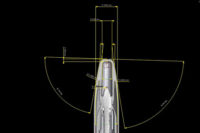ASME Guest Column
Fundamentals Matter: Why GD&T Remains Essential in Modern Manufacturing
Mastering these fundamentals is essential to pushing the boundaries of modern technology.

Image Source: vm / E+ / Getty Images
In an era where emerging technologies like artificial intelligence, quantum computing, and humanoid robotics dominate the headlines, it’s easy to overlook the foundational principles that make these breakthroughs possible. Yet, behind every cutting-edge application is a bedrock of engineering fundamentals—principles that have guided innovation for decades. Whether it’s understanding material science for designing next-gen batteries or applying classical control theory to autonomous systems, mastering these fundamentals is essential to pushing the boundaries of modern technology. ASME’s Y14.5 Standard, which describes the art and science of geometric dimensioning and tolerancing (GD&T), is among these fundamentals for advanced manufacturing.
Why GD&T Matters
The GD&T standard is an essential tool for communicating design intent across the manufacturing lifecycle – how the parts created from technical drawings have the desired form, fit, function, and interchangeability in the intended application. The common language known as GD&T can help facilitate communication amongst key personnel responsible to produce a part, from colleagues involved in design and manufacturing to quality assurance teams and external suppliers. ASME’s Y14.5 Standard establishes symbols, rules, definitions, requirements, defaults, and recommended practices for stating and interpreting GD&T and related requirements to produce and interpret engineering drawings.
By improving communication, the symbolic language of GD&T impacts business results by ensuring that tolerances are optimized based on technical requirements and that acceptable levels of variance are defined for production parts, which can save time, money, and help to improve a manufacturer’s business reputation through improved on-time delivery, product reliability, and reduced warranty claims. GD&T principles help engineers and other technical professionals to identify and address potential manufacturing and assembly issues early in the design phase when it’s much less costly to address (versus during or after the manufacturing phase).
GD&T Complements Automation
The fundamental principles of GD&T apply regardless of advances in manufacturing processes and new factory automation technologies. Why? Because all manufacturing processes introduce variations from the ideal computer-aided design (CAD) model representation that must be managed by design (creating specification) and manufacturing teams (translating design specifications to machine setup and operation).
With the right combination of engineering design software and coordinate measuring machine (CMM) software, GD&T can be used to automate or streamline inspection and measurement tools used by quality control technical professionals. Data from inspection reports can be used to drive further process or design optimizations to ensure the right mix of precision and profitability for a given part. For example, consider additively manufactured parts that have elements of generative design with organic shapes that often require hard mounting points or mating features that necessitate precise control in many demanding applications. Automated inspections are a pragmatic solution as designs optimized for additive manufacturing processes become more commonplace in industry.
What’s Next for GD&T? MBD
Manufacturers are increasingly using model-based designs (MBD), which serve as a digital single source of truth for product manufacturing information across the manufacturing lifecycle. MBD replaces traditional two-dimensional drawings with a 3D annotated model that contains the necessary information for manufacturing, inspection, and quality control steps. MBD reduces (and can sometimes eliminate) the ambiguities and potential misinterpretations associated with 2D drawings.
By embedding GD&T directly within the 3D CAD model, MBD provides a clear, unambiguous, and visually rich representation of the design intent. The richer visual context minimizes the risk of errors during manufacturing and inspection, which can ultimately lead to improved product quality and reduced scrap rates. MBD eliminates the time-consuming, error-prone process of creating and revising (often ignored) 2D engineering drawings. This compresses the timeline from design to manufacturing, enabling companies to bring products to market faster. By reducing lead times, MBD can help companies stay ahead of the competition and capitalize on new market opportunities.
Investing in GD&T Education Pays Dividends
GD&T is a technical topic that impacts business outcomes by improving manufacturing margins, profitability, and industry reputation. Successful organizations invest in staff skills alongside an implementation strategy to ensure it’s tailored to their business needs, processes, staff competencies, technologies, and industry best practices to realize maximum benefits. An organizational culture that values manufacturing excellence, when combined with GD&T skills, creates a symbiotic relationship that optimizes profitability and customer satisfaction.
To Innovate, First Get Back to Basics
As technology continues to evolve, the tools and applications may change, but the underlying engineering principles remain as vital as ever. Engineers who excel in new fields are those who can bridge the gap between time-tested fundamentals and the latest innovations. In a fast-paced tech landscape, the engineers who succeed will be the ones who never forget that innovation is not just about what’s new—it’s about how well you apply the knowledge that has stood the test of time. By staying grounded in essential engineering fundamentals which include GD&T, we can ensure that our manufacturing advances are not just exciting, but sustainable and reliable for generations to come.
Looking for a reprint of this article?
From high-res PDFs to custom plaques, order your copy today!





